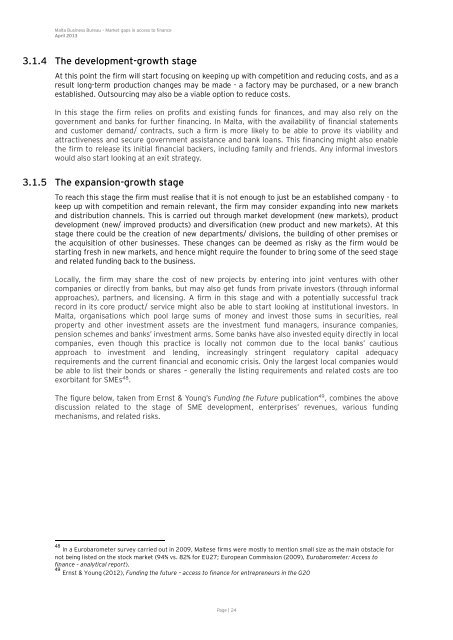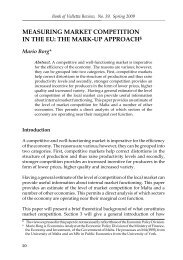Market Gaps on Access to Finance - Bank of Valletta
Market Gaps on Access to Finance - Bank of Valletta
Market Gaps on Access to Finance - Bank of Valletta
You also want an ePaper? Increase the reach of your titles
YUMPU automatically turns print PDFs into web optimized ePapers that Google loves.
Malta Business Bureau – <str<strong>on</strong>g>Market</str<strong>on</strong>g> gaps in access <strong>to</strong> finance<br />
April 2013<br />
3.1.4 The development-growth stage<br />
At this point the firm will start focusing <strong>on</strong> keeping up with competiti<strong>on</strong> and reducing costs, and as a<br />
result l<strong>on</strong>g-term producti<strong>on</strong> changes may be made - a fac<strong>to</strong>ry may be purchased, or a new branch<br />
established. Outsourcing may also be a viable opti<strong>on</strong> <strong>to</strong> reduce costs.<br />
In this stage the firm relies <strong>on</strong> pr<strong>of</strong>its and existing funds for finances, and may also rely <strong>on</strong> the<br />
government and banks for further financing. In Malta, with the availability <strong>of</strong> financial statements<br />
and cus<strong>to</strong>mer demand/ c<strong>on</strong>tracts, such a firm is more likely <strong>to</strong> be able <strong>to</strong> prove its viability and<br />
attractiveness and secure government assistance and bank loans. This financing might also enable<br />
the firm <strong>to</strong> release its initial financial backers, including family and friends. Any informal inves<strong>to</strong>rs<br />
would also start looking at an exit strategy.<br />
3.1.5 The expansi<strong>on</strong>-growth stage<br />
To reach this stage the firm must realise that it is not enough <strong>to</strong> just be an established company - <strong>to</strong><br />
keep up with competiti<strong>on</strong> and remain relevant, the firm may c<strong>on</strong>sider expanding in<strong>to</strong> new markets<br />
and distributi<strong>on</strong> channels. This is carried out through market development (new markets), product<br />
development (new/ improved products) and diversificati<strong>on</strong> (new product and new markets). At this<br />
stage there could be the creati<strong>on</strong> <strong>of</strong> new departments/ divisi<strong>on</strong>s, the building <strong>of</strong> other premises or<br />
the acquisiti<strong>on</strong> <strong>of</strong> other businesses. These changes can be deemed as risky as the firm would be<br />
starting fresh in new markets, and hence might require the founder <strong>to</strong> bring some <strong>of</strong> the seed stage<br />
and related funding back <strong>to</strong> the business.<br />
Locally, the firm may share the cost <strong>of</strong> new projects by entering in<strong>to</strong> joint ventures with other<br />
companies or directly from banks, but may also get funds from private inves<strong>to</strong>rs (through informal<br />
approaches), partners, and licensing. A firm in this stage and with a potentially successful track<br />
record in its core product/ service might also be able <strong>to</strong> start looking at instituti<strong>on</strong>al inves<strong>to</strong>rs. In<br />
Malta, organisati<strong>on</strong>s which pool large sums <strong>of</strong> m<strong>on</strong>ey and invest those sums in securities, real<br />
property and other investment assets are the investment fund managers, insurance companies,<br />
pensi<strong>on</strong> schemes and banks’ investment arms. Some banks have also invested equity directly in local<br />
companies, even though this practice is locally not comm<strong>on</strong> due <strong>to</strong> the local banks’ cautious<br />
approach <strong>to</strong> investment and lending, increasingly stringent regula<strong>to</strong>ry capital adequacy<br />
requirements and the current financial and ec<strong>on</strong>omic crisis. Only the largest local companies would<br />
be able <strong>to</strong> list their b<strong>on</strong>ds or shares – generally the listing requirements and related costs are <strong>to</strong>o<br />
exorbitant for SMEs 48 .<br />
The figure below, taken from Ernst & Young’s Funding the Future publicati<strong>on</strong> 49 , combines the above<br />
discussi<strong>on</strong> related <strong>to</strong> the stage <strong>of</strong> SME development, enterprises’ revenues, various funding<br />
mechanisms, and related risks.<br />
48 In a Eurobarometer survey carried out in 2009, Maltese firms were mostly <strong>to</strong> menti<strong>on</strong> small size as the main obstacle for<br />
not being listed <strong>on</strong> the s<strong>to</strong>ck market (94% vs. 82% for EU27; European Commissi<strong>on</strong> (2009), Eurobarometer: <strong>Access</strong> <strong>to</strong><br />
finance – analytical report).<br />
49 Ernst & Young (2012), Funding the future – access <strong>to</strong> finance for entrepreneurs in the G20<br />
Page | 24







